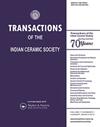以粉煤灰为烧结添加剂制备莫来石粘结多孔SiC陶瓷膜的渗透性能和废水过滤性能
IF 1.5
4区 材料科学
Q3 MATERIALS SCIENCE, CERAMICS
引用次数: 5
摘要
以碳化硅为起始粉末,废粉煤灰为烧结添加剂,金属氧化物为催化剂,采用常规固相反应方法,在1000°C下制备了莫来石-碳化硅陶瓷膜。使用实验室制作的装置获得空气和水流测试中的渗透性参数,并在可变跨膜压力下测量纯水渗透性。该膜表现出5261L.m−2.h−1.bar−1的优异纯水通量,开孔率为44.7%,平均孔径为3.7μm。该膜对初始含油浓度为1657mg.L-1的厨房废水的除油效率高达91%。这里开发的方法在技术上是良性的,并通过利用危险废物材料以降低的成本制造具有良好机械、渗透特性和废水过滤效率的多孔SiC陶瓷膜来防止环境污染。因此,所提出的SiC膜方法具有良好的可持续性,并且可扩展用于含油废水处理。图形摘要本文章由计算机程序翻译,如有差异,请以英文原文为准。
Permeability Behavior and Wastewater Filtration Performance of Mullite Bonded Porous SiC Ceramic Membrane Prepared Using Coal Fly Ash as Sintering Additive
With SiC as starting powder, waste fly ash as sintering additive and metal oxide as catalyst, mullite bonded SiC ceramic membrane was prepared at 1000°C using the conventional solid-state reaction method. Permeability parameters in both air and water flow tests were obtained using laboratory made set-up and the pure water permeability was measured at variable transmembrane pressures. The membrane exhibited excellent pure water flux of 5261 L.m−2.h−1.bar−1 with open porosity of 44.7% and mean pore size of 3.7 μm. With this membrane a high oil removal efficiency of 91% was achieved from the kitchen wastewater having initial oil concentration of 1657 mg.L−1. The method developed here is technologically benign and addressed prevention of environmental pollution by utilizing hazardous waste material for fabrication of porous SiC ceramic membrane at a reduced cost with good mechanical, permeability characteristics and wastewater filtration efficiency. Hence, the proposed method for SiC membranes has good sustainability and is scalable for oily wastewater treatment. GRAPHICAL ABSTRACT
求助全文
通过发布文献求助,成功后即可免费获取论文全文。
去求助
来源期刊

Transactions of the Indian Ceramic Society
工程技术-材料科学:硅酸盐
CiteScore
2.40
自引率
8.30%
发文量
12
审稿时长
2.3 months
期刊介绍:
Transactions of the Indian Ceramic Society is a quarterly Journal devoted to current scientific research, technology and industry-related news on glass and ceramics. The Journal covers subjects such as the chemical, mechanical, optical, electronic and spectroscopic properties of glass and ceramics, and characterization of materials belonging to this family.
The Editor invites original research papers, topical reviews, opinions and achievements, as well as industry profiles for publication. The contributions should be accompanied by abstracts, keywords and other details, as outlined in the Instructions for Authors section. News, views and other comments on activities of specific industries and organizations, and also analyses of industrial scenarios are also welcome.
 求助内容:
求助内容: 应助结果提醒方式:
应助结果提醒方式:


